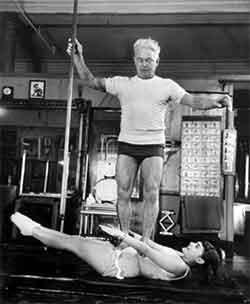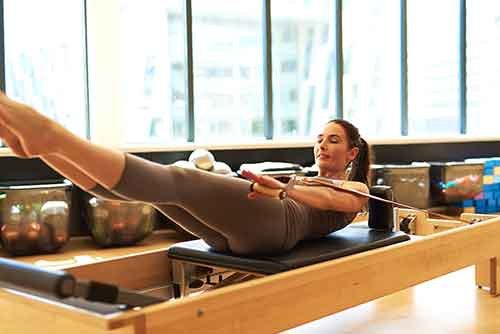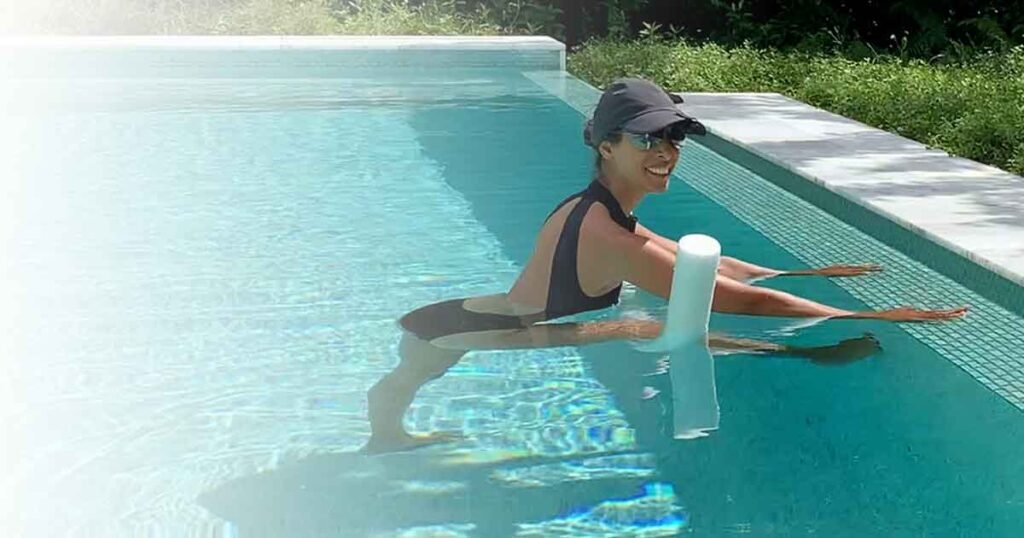The Pilates method, renowned for its extensive history and development, has gained global recognition. Whether you’re new to it or just eager to learn more, here’s a concise and straightforward overview of “what is Pilates?”
“Joseph Pilates was truly ahead of his time,” is a statement I often make. He had an insight into something crucial for our health and well-being, something we hadn’t fully appreciated until now. Especially in today’s world, its importance is more evident than ever. Just wait, you’ll see why soon enough… stick with me 😉
A quick history lesson: The Pilates method was developed in the early 1920s by Joseph H. Pilates. This method has been continuously evolving, and in recent years, it has gained tremendous popularity. More studios are now offering Pilates classes, physical therapists are adopting the technique along with its specialized apparatuses, and clothing companies are marketing Pilates apparel and gear. There’s also a proliferation of online classes, teacher trainings, and courses. It’s a flourishing industry, all under the name PILATES.

“The Pilates method teaches you how to be in control of your body and not at its mercy”
Joseph Pilates
But what is Pilates really?…
The Pilates method, originally known as “Contrology,” was developed by Joseph Pilates in the early 20th century. Pilates recognized the importance of treating the body as an integrated whole, combining mind, body, and spirit in his exercise regimen. For a deeper understanding of his holistic approach to health, his book “Return to Life Through Contrology” is an excellent resource.
Despite creating his method during a time when knowledge of body anatomy and physiology was limited, Joseph Pilates was a pioneer in his field. He gained insights through his active lifestyle, as well as by observing nature and wildlife. Central to his discipline was the concept of the “powerhouse” – what we now refer to as the core muscles. Pilates believed that these muscles were crucial for maintaining a controlled and healthy body. This foundation laid the groundwork for what has evolved into the modern Pilates method.
Focusing on activating the deep core muscles, practicing correct breathing, and maintaining spine alignment are fundamental principles in every exercise of this method. It trains you to work from the inside out, reestablishing the body’s natural mechanism of engaging deep stabilizer muscles before involving the larger, more global mover muscles.
What Are the Different Forms of Pilates?
The Pilates method has gained widespread popularity due to its versatility, appealing to a broad range of individuals. It offers a diverse array of exercises, both on the mat and using specialized equipment, allowing numerous ways to move the body. This diversity not only aids in building strength and flexibility but also leaves practitioners feeling rejuvenated and energized after each session.
Pilates can be practiced on a mat, utilizing one’s own body weight or small props such as rings, balls, bands, and more. Additionally, it incorporates larger apparatuses, many of which were invented by Joseph Pilates himself. The most popular of these include the Reformer, Cadillac, Chair, and Barrel. In the accompanying video, I demonstrate an advanced variation on the Cadillac, showcasing the dynamic and challenging nature of Pilates exercises with these specialized machines.

The Pilates Principles
Dedicated to his life’s work, Joseph Pilates founded this mind-body method on six principles, which are key to the successful performance of all exercises: Breathing, Centering, Concentration, Control, Precision, and Flow.
1. Breathing
Joseph Pilates placed great emphasis on deep, full breathing. By fully expanding and contracting the lungs, the goal is to infuse more fresh oxygen into the bloodstream, effectively creating an “internal shower.” This process rejuvenates and purifies the blood, leading to more efficiently functioning organs and glands, energizing the body, and restoring vitality and vigor.
2. Centering
Focusing on the body’s center, particularly the core muscles, often referred to in Pilates as the “powerhouse,” is essential during each exercise. This involves initiating every movement from the body’s center by bringing awareness to these core muscles, correctly recruiting them in synchronization with the breath.
3. Concentration
Incorporate mindful movement into your practice by bringing awareness and consciousness to each exercise. Be present in the moment, focusing mindfully on each movement to execute them correctly. This approach not only helps you master your practice until it becomes a subconscious part of you but also benefits your daily physical activities.
4. Control
As suggested by its original name, “Contrology,” Joseph Pilates intended to highlight the concept that your mind should direct and control each individual muscular movement. To achieve a healthy and strong body, it’s crucial to have control over your body, rather than the other way around.
5. Precision
Maintaining a conscious awareness of precision in every movement of each exercise is essential. This involves attentively following the instructions and cues regarding body placement, alignment, and the trajectory of each moving part of the body.
6. Flow
Pilates exercises should be performed in a flowing manner, aiming for fluidity, elegance, and grace. Each movement should seamlessly transition into the next, creating a complete choreography. In my opinion, this concept is best applied on the mat, where there’s no need to adjust springs or other machinery for each exercise. It’s just you, the mat, and possibly small props (such as a ring, ball, resistance band, etc.), allowing for free and fluid movements.

Quality Over Quantity in Exercise
When contemplating the essence of Pilates, think of it as the epitome of “quality over quantity” in exercise. Pilates practitioners, whether on mats, using apparatus, or in water, engage in a comprehensive mind-body workout. This method involves a full-body approach, focusing on developing strength, balance, functional ability, and flexibility. A key aspect of Pilates is the emphasis on breath control and maintaining optimal spinal and pelvic alignment. This approach fosters a deep connection with one’s body, ensuring control over the intricate machine that carries us through life.
Who Benefits from Pilates?
For those seeking to increase their strength, flexibility, and stability, Pilates is the answer. Individuals aiming for a pain-free experience with improved joint mobility and fluidity will find it beneficial. Athletes looking to enhance their physical skills or recover from injuries will find it ideal. It’s also advantageous for pre- and postnatal phases. Ultimately, anyone eager to feel good and vital through enjoyable body movement will appreciate Pilates.
Drawing on over 15 years of experience in practicing and teaching Pilates, I’ve realized its universal benefits. It genuinely works for everyone!
Summary
Pilates, a holistic exercise method developed by Joseph Pilates, harmonizes strength, flexibility, and mental focus. This article explores its foundational principles, including deep breathing and precise movements. Moreover, we emphasize its versatility, catering to individuals of all levels, from athletes to beginners. We delve into a variety of practices, encompassing both simple mat routines and equipment-based exercises. Drawing from extensive teaching experience, this guide exemplifies the universal benefits of Pilates. It offers valuable insights, making it an ideal resource for both seasoned practitioners and newcomers alike. Pilates is more than exercise; it’s a pathway to enhancing daily life and overall well-being. Why not give it a try?



